Don’t you just love embroidery projects that allow you to stitch seemingly endless lines of design, without having to start and end your threads often?
In Stitching Heaven, we’ll be able to stitch indefinitely, with miraculously never-ending threads that don’t fray, that don’t tangle. When we want to change colors or thread types, we will merely think it, and it will be done. We won’t have knots on the back of our fabric and every stitch will cooperate. We won’t make mistakes, but we might change our minds. And when we change our minds, previous stitches will disappear as quickly as we can breathe the wish.
Sounds nice, doesn’t it?
After a while, though, I’d get bored. The challenges of stitchery – and overcoming the challenges – may not be half the fun of embroidery, but they are almost all the satisfaction. If you didn’t have to overcome any challenge at all when stitching, would you be nearly as satisfied with your finished project?
One challenge that we have all faced at some point is that of starting and ending threads in a way that is secure, that makes sense for the particular project, and that won’t impair the finished design.
Today, I’ll show you how I’m starting and ending stitches on the Hungarian Redwork Runner. These are methods we’ve discussed before, but here, you’ll see them in action on a real project. I’ve made one alteration in the ending of my threads, though, for this particular project, so we’ll look at that up close and I’ll tell you why I’m doing it.
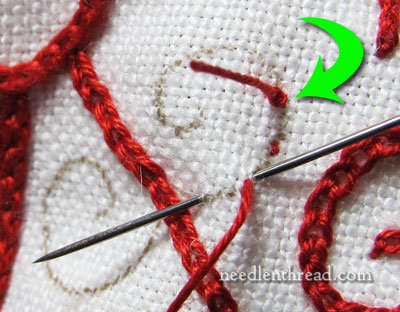
If you take a look at the final design that I used for the Hungarian Redwork Runner project, you’ll notice that there are many starts and stops in the design. Little curls, big curls, broken straight lines, small wavy lengths – on this project, I have to start and end threads All The Time.
Now, this might sound a bit more like Stitching Hell than Stitching Heaven, and it could be, if I let it be. But as Milton would say, “The mind is its own place, and in itself, can make heaven of Hell, and a hell of Heaven.” In other words, it’s all in the attitude! If you accept the fact that you’ll be starting and stopping a lot and don’t let this fact bug you – just look at it as part of the process – then it’s not nearly as big a deal.
To start the threads for this project, I’m using a waste knot on the top of the fabric (see the green arrow in the photo above), after which I take about three tiny, spaced backstitches towards my starting point.
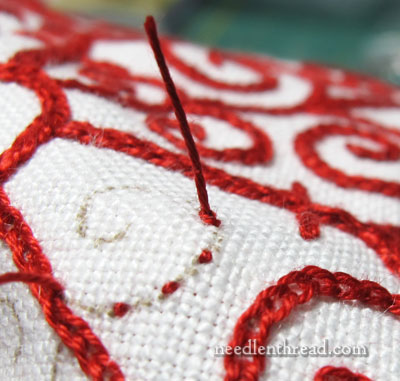
Here are the three little backstitches, and my working thread (on the left side of the photo, right up next to the chain stitched line) is now in position to start stitching that curl. The stitching direction will be towards the knot.
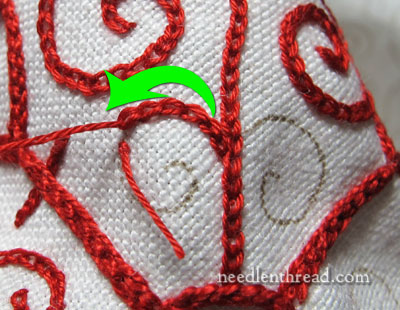
Here I am, heading towards the knot. Hello, knot!
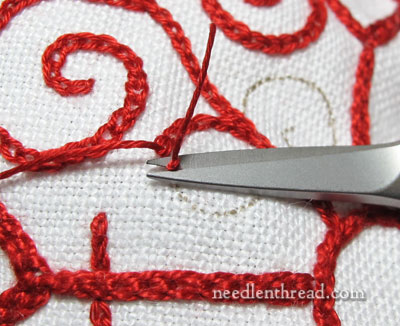
Once I arrive within spitting distance of the knot, I pull it up and snip it off. Goodbye, knot!
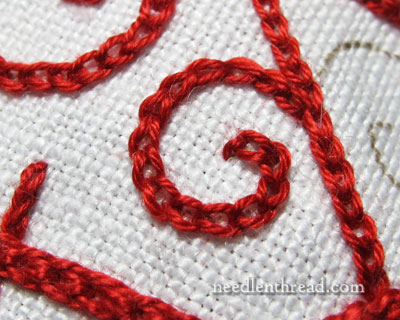
And then I continue on my merry way, finishing the curl.
This is a close-up photo of the curl, which is stitched in chain stitch using coton a broder (aka “cutwork” thread) #25 in color 321. Even this close up, you’re pretty hard-pressed to tell exactly where those backstitches are, right? They’re completely covered, even though the chain stitch is a relatively open stitch, compared to other line stitches.
And my starting thread is perfectly secure. Not only does it begin with those backstitches, which are secure in themselves, but then it is further stitched over with the chain stitches. It’s S-E-C-U-R-E. And it’s happy. And I’m happy.
I love starting threads this way! Especially on an embroidered piece where the back is not covered, this is a clean and simple way to secure the starting thread.
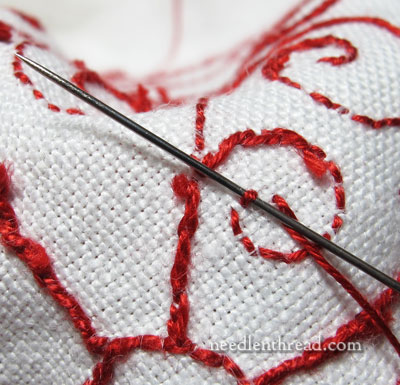
Now let’s migrate to the Back of the Piece, where things start looking a bit hairy and not too attractive. The perle cotton used for the heavier lines is much thicker and more difficult to hide in a slender, subtle way on the back. The coton a broder is much easier to finish off on the back, because it’s not only a finer thread, but it’s not as tightly twisted. Though they are such different threads, I end them both the same way.
If I were able to take some small backstitches in an adjoining line that would eventually be covered with stitches, I’d end the thread the same way I started it. But in most situations on this design, that’s not possible. So, in most instances, I have to whip the working thread around the stitches on the back of the piece.
You can see in the photo above that I’m heading underneath the back of one of those stitches.
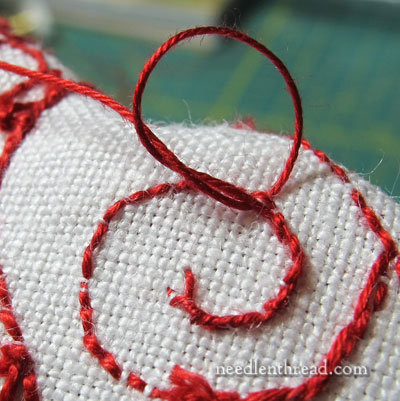
I whip the thread around 8 or so stitches on the back, and then… and then….
… and then I do something that I don’t normally do on the back of my embroidery.
I tie a knot.
Noooooooo! Not a Knot, you say!
Yes. A knot! I say.
It’s just a simple overhand knot, and I pull it so that the knot cinches up right next to the stitches on the back. Then I clip the thread close.
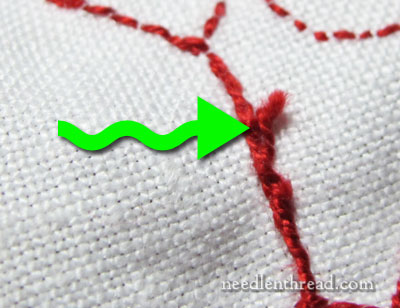
Why the knot? Because of Tweakers. The green arrow above points to a Tweaker. Tweakers are annoying, hairy, bouncy, intrusive things. And we don’t like them on the back of this type of embroidery.
The perle cotton especially is prone to tweaking, and if you merely whip around the stitches on the back (even if you “hitch” the thread by taking one whip stitch backwards and then moving forward again), when you trim that perle cotton, it’s going to retain the tendency to scooch out of its situation. And as it scooches, it will form a Tweaker.
Now, you can trim the Tweaker, but trimming a Tweaker is a lot like cutting the tail off a lizard. It’ll come back. And you can only trim Tweakers so far, before you end up without any thread left to tweak on you.
The thread needs something to restrain it from tweaking about, and I like a tight little overhand knot for this job. It is subtle, and it restrains the loose thread ends.
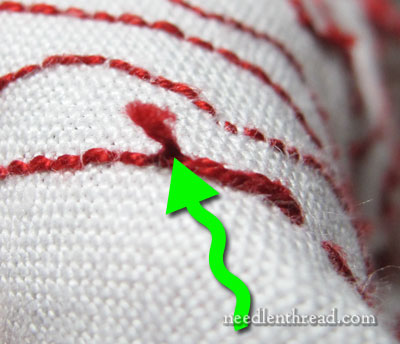
Here’s another Tweaker.
Can you see why I don’t want the rotten little things on the back? So, I tie a knot, and it helps. Mind you, the knot is small – it’s not a big, lumpy knot. Just one overhand twist cinched firmly is all it takes.
When the piece is finished and washed for the first time, a little miracle called Shrinkage will happen, and this will also help reduce the tendency of the threads to move. The thread will shrink – ever so slightly, but just enough to allow it to grip the threads around it.
So that’s how I’m starting and ending the threads on this project. I’ll share an update with you on the project soon, so you can see how far it’s come.
What about you? How do you end threads on the backs of table linens and the like, when the backs will be exposed and the item will be washed? Any tricks you’ve learned that you’d like to share? Feel free to leave a comment below – we’re all ears!
If you’d like to see this project from its developmental stages until now, including tips and materials and all that good stuff, feel free to visit the Hungarian Redwork Runner project index.







That is the best bit of advice about finishing off loose ends. I am plagued by them. Now, I won’t be. Thank you so much.
Can one add a knot when ending the stitch with stranded cotton thread ? In items that are washed often, I find that the stitch is not really secured if I just whip around a few stitches on the back.
mary
if i have a tweaker on the back of my canvas, i use a little bit of fray check, wait until it dries and then clip it close to the back. works all the time.
I’m so glad you are Real about things related to needle and thread Mary. Challenges, knots, finished things, UFO’s, stitches, needles, set up, fabric, starting and ending… the whole Real Thing. Your cyberspace presence makes the stitching journey, fun.
Hi Mary, Wonderful and so detailed info. I try to weave into stitches on the particular line that I have just finished, on the back of course. Yes, I am guilty of knots. Bad, I know. Many times if I’m using a thin linen or white linen I will start with a piece of muslin behind the linen and I don’t get any shadow from the back threads. Don’t know if all of this is right or wrong, but it is the way I was taught, but I am definitely open for any and all
better techniques.
Mary, how do you cinch down the overhand knot so it is placed right at the fabric surface? When I do it the knot always wants to tighten up higher on the thread even though I use my needle to try to tease it down.
Hi, Molly – Stick your needle in the loop of the knot before you tighten it, and press the needle down onto the fabric, so that it’s holding the knot where you want it, and then tighten it. Don’t try to tease it down after you’ve already started tightening it – just use the needle inside the loop to hold it exactly where you want it, and tighten it with a quick little tug. Works every time! ~MC
Why thank-you, Mary, I see what you mean. I’ll try that next time. Your expertise is amazing and your generosity sharing it is so appreciated.
Thanks so much for the great tutorial. You explained it so very well. Your photos are great too.
Interesting: I’ve learned some new words today. When backstitching in cross stitch I do the very same thing. I like using the waste knot, and I prefer to run the ending tail under the stitched threads on the back. Mostly I do the little whip through the loop and make a mini knot to end it. I thought I was cheating but knowing that you do it, I feel much better, no knotty police will come after me. LOL
And did you ever explain how to finish off a tail when there are random french knots sprinkled across a piece (like snow)? Maybe I should check your archives for that one.
Hi, Irene – Normally, I avoid knots altogether. But on this piece, the thread (especially the perle cotton) refuses to stay put! On framable pieces, the concern about knots is that they may leave a small visible bump on the front, but if this isn’t the case, then I wouldn’t worry about it.
My biggest concern here is that the back is at least “acceptably” neat and that the perle cotton doesn’t unwind from around the stitches on the back. It’s the one thing I didn’t notice about the thread until well after I started. I tested colorfastness for washing, I tested thread size and bulk with the stitch…. but I never really noticed what a pain it is on the back of the fabric. If I had realized it, I probably would’ve just gone with the coton a broder for the whole piece…
MC
Thank you so much for the instructions/tip with the waste knot and back stitches!
Anyone who can take such beautiful photos, stitch such luscious designs, and quote Milton is destined for stitching heaven! Now I know why your blog is the only one I read every day!
Perfectly stated! And a wonderful post today Mary! Thank you.
Really helpful and understandable, Mary! Thank you so much for this post.
I am teaching a stump work class and will have to try this technique with my class. Thank you, l always send my students to your stitch videos if they have trouble between classes.
Dear Mary
What a great post and very helpful, a good way of starting stitching I will definitely use this technique. Equally a great demonstration on how to hide tweakers, yes I am sick of these as well and and will take your advice and knot them in future.
Thanks
Regards Anita Simmance
I am enjoying the porgress of your redwork piece. I like your suggestion for beginning and ending a thread.
You crack me up!,
Tweakers! Ha!
Hi Mary,
I follow your method for starting embroidery with the waste knot and tiny stitches, and am quite proud that I can (theoretically, at least) make the back of the embroidery look nice and neat without bumpy knots. I have ended threads as you do on occasion, and need to make a mental note to do so more often. I like the little knot at the end of whipping the thread around the stitches. No Tweakers for me! Thanks for this post, it’s given me one of those Aha! moments.
Anything can be going on. I teach elementary art and need to “decompress” whenever I can! I have a spot on my hearth where I sit more often than any other place. I have a table set up with a floor lamp next to it. When alone (husband out of town) I will sit there for hours in the evening, watching (listening) to movies. My very old black and white cat will sit right next to me especially if there is a fire in the fireplace! Small projects go to school with me. When out at our ranch where ere is no television reception, i listen to books on tape while needlepointing. When the students are involved in their work I will often pull my project out and do a few stitches on it. They love to see what I am working on. Come to think of it, I always have something to work on with me. You never know when there will be some down time.
Jenny Young
Dear Mary, Thank you for posting about starting & stopping your threads. When I looked at your photos, I thought I was having a senior moment until I checked your archives. You ARE using a combination of Hungarian braided chain & chain stitch on this project. OK–after testing your thread options, you decided to switch stitches rather than switch threads to create the desired effect?? After watching your tutorial on Hungarian braided chain, I stitched a 5×5 test swatch. WOW–what a thread hog!! Forty yards of Wildflowers to finish a small design. Hope you’ve got plenty of thread on hand for your design.
Bless you Mary, Finally someone who isn’t afraid to show the back of their work. When I started stitching, I would look at the back of other people’s work to see how the treads were ended. You would of thought that I did the most unethical thing imagined. I still have trouble with those little fuzzy slip out ends, but now I know how to handle them. You are the best teacher that I have had the privilige of knowing. Thank you.
This is a late post, but I hope it will be helpful to others. I first learned to surface embroider at age 6, many years ago. 🙂 All the women in my mother’s family ALWAYS made small knots to begin and end stitching on any surface embroidery, since it would inevitably be laundered over and over again…they were embroidering clothing and household linens. I know that the purists hate this, but practicality wins out. I still knot my examples of these types of work…a small, single knot can hold very well and is quite neat on the backside.
Judged pieces CANNOT have knots. It’s one of the first things the judges look for.
For Hardanger and drawn work I use backstitches or weaving in the ends, but have the problem with “tweakers” (LOVE that term!) in pearl cotton and twisted silk. I have found a VERY SMALL drop of Fray Check on the end will “glue” it down to the other threads without leaving a noticeable bump. I apply it with the tip of a needle to better control the amount. The needle cleans easily when you’re done by wiping while still damp with some rubbing alcohol.
quite amazing
Muchisimas gracias por esta pagina tan llena de enseñanzas. Soy muy nueva en el arte del bordado pero muy apasionada, asi que aqui en contré lo que necesitaba.